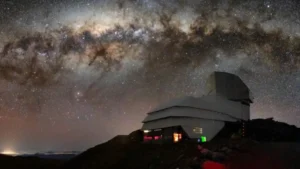It seems that Bruce Willis and Ben Affleck’s mission to blow up an asteroid in the film Armageddon is not as farfetched as we’d thought. Tomorrow, on November 24, 2021, NASA will launch a spacecraft that will crash into an asteroid to test whether or not we are capable of redirecting it.

Asteroids in space. Photo: Vadim Sadovski/Shutterstock
The Chelyabinsk wake-up call
After the close call with the Chelyabinsk cosmic airburst in 2013, scientists began to seriously consider the need for a planetary defence strategy. The Chelyabinsk asteroid was an unexpected encounter, a 17m space object that completely missed Earth’s tracking systems and telescopes since it was coming from the sun’s direction. Missing asteroids happens quite often, especially when there is light pollution from the sun or nearby constellations. The Chelyabinsk incident resulted in intense heat, destruction of property, and numerous injuries.
NASA calls this mission DART (Double Asteroid Redirection Test). The plan is quite simple. The DART spacecraft will travel to the target asteroid over 10 million kilometres away from Earth. It will then strike the asteroid at 6.6km per second and hopefully change its orbit by at least 1%. It is essentially a kamikaze mission that costs US$330 million.
The asteroid of choice is a 160m rock called Dimorphos, which means “two forms” in Greek. It orbits a bigger asteroid or moonlet (780m) called Didymos, which appropriately means “twin”. The two asteroids are about 4.5 billion years old.
They are at a safe distance from Earth and are not heading for our planet, so no matter what happens with the experiment, the pieces will not affect us. Changing Dimorphos’s orbit will not affect the course of its larger twin. If successful, astronomers will see a big difference in the the pair’s brightness as Dimorphos is supposed to eclipse Didymos every 12 hours.

A diagram of the DART mission spacecraft. Photo: NASA
Star Wars-themed cameras
The spacecraft is a box measuring 1.14m x 1.24m x 1.32m, approximately the size of a refrigerator. When activated, it will have a solar panel wing span of 18 m across. It contains the DRACO (Didymos Reconnaissance and Asteroid Camera for Optical navigation), a telescope that also acts as a navigator, NASA’s Evolutionary Xenon Thruster (NEXT-C) ion engine, and the LICIACube (Light Italian CubeSat for Imaging of Asteroids). For this mission, the John Hopkins Applied Physics Laboratory and Agencia Spaziale Italiana are collaborating with NASA.
Ten days before impact, the LICIACube will detach from the DART craft in order to capture images of the impact along with any topographical changes like craters, space debris, etc. The LICIACube contains two Star Wars-themed pieces of equipment: LUKE (LICIACube Unit Key Explorer) and LEIA (LICIACube Explorer Imaging for Asteroid). These are special cameras that will relay data back to mission control at Turin, Italy and from there to NASA.
While the DART will be destroyed, the LICIACube will fly past the asteroids and further into space until it is shut down by mission control or eventually runs out of power. Both DART and LICIACube will be launched from the Vandenberg Space Force Base in California aboard a SpaceX Falcon 9 rocket. The craft will weigh 612kg.

Illustration of DART spacecraft with solar panels out. Photo: NASA
A test for small asteroids only
This first Planetary Defense Test Mission will only show whether we can affect smaller, city-destroying asteroids. Extinction-levels threats might require a nuclear solution. However, scientists reassure us that encountering an asteroid of this size in our lifetime is not likely.
As of today, there are over 27,000 asteroids flying near the Earth, and 10,000 of them are more than 140m in size. The likelihood of a Chelyabinsk impact is 1 in every 100 years. The likelihood of a bigger impact is 1 in every 500,000 years.
Scientists expect DART’s impact to take place a year from launch.






